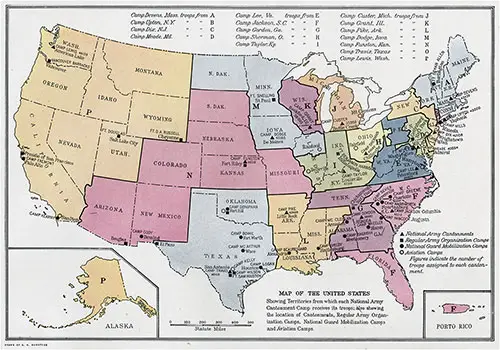🪖 Training Camps and Cantonments of World War I
The map below, published by National Geographic in November 1917, shows the territories assigned to each cantonment camp. It remains one of the most iconic visual records of America’s wartime mobilization.
Map of the United States Showing Territories from which Each National Army Cantonment Camp Receives its Troops. The National Geographic, November 1917. | GGA Image ID # 231d65e46e
When the United States entered the Great War in April 1917, the Army had facilities for just 124,000 officers and men. Within a year, the War Department’s Cantonment Division had created housing, utilities, and infrastructure for more than 1.5 million soldiers. These camps were not just barracks — they were instant cities with roads, power plants, water supply, hospitals, recreation halls, and training grounds.
For teachers and students 🎓, these camps illustrate America’s rapid mobilization.
For genealogists 🧬, they provide context for where ancestors trained before going overseas.
For historians 📚, they are case studies in military engineering, social change, and the birth of America’s “citizen army.”
📖 Highlights from the Collection
📍 National Army Cantonments (1917)
Sixteen sprawling training cities built almost overnight. Each had a unique identity, name, and regional connection. Brochures and reports described their location, climate, and role in preparing divisions for France.
America’s New Soldier Cities (1917) – An overview of the 16 cantonments.
The National Army Cantonments (1917) – Descriptions, maps, and naming histories.
WWI Training Camp Activities (1917) – War Department brochure on recreation and morale.
Temporary camps for state units mobilized into federal service. Reports describe facilities, climate, and the communities that grew up around them.
📍 Life in the Camps
Making a Soldier Out of Johnnie (1918) – Edward Hungerford’s popular magazine article capturing daily life.
Hostess Houses for Everybody (1918) – Y.W.C.A. hospitality centers that welcomed women visiting soldiers.
An American Cantonment (1919) – Observations of camp life and the “homogeneous” citizen army.
📍 Individual Camp Collections
Each camp had its own character, often remembered through photo books, pictorial histories, and reports:
Camp Devens (Massachusetts) – Home of the 76th Division; includes pictorials and an officers’ training camp yearbook.
Camp Dix (New Jersey) – Called a “model city” with full modern infrastructure.
Camp Dodge (Iowa) – Established June 1917, training ground for the 88th Division.
Camp Funston (Kansas) – The largest of its kind, housing up to 50,000 men.
Camp Grant (Illinois) – Training quarters for northern Illinois and Wisconsin troops.
Camp Pike (Arkansas) – Named for Zebulon Pike; home to the 87th Division.
Camp Zachary Taylor (Kentucky) – Louisville-based cantonment serving as a major training site.
Third Officers Training Camp - US Army - Camp Devens - 1918 - Command Training Officers, Roster of Cadets, Unit History, and Statistics for each training group of the Third Officers Training Camp at Camp Devens.
📸 Noteworthy Images
Map of the U.S. (1917) – Showing regional recruitment zones for each camp.
Construction Photos – Roads, barracks, utilities, and “instant cities” rising in months.
Hostess Houses & YMCA Halls – Social and recreational life alongside military training.
Group Portraits – Soldiers in formation, on parade, and in camp life.
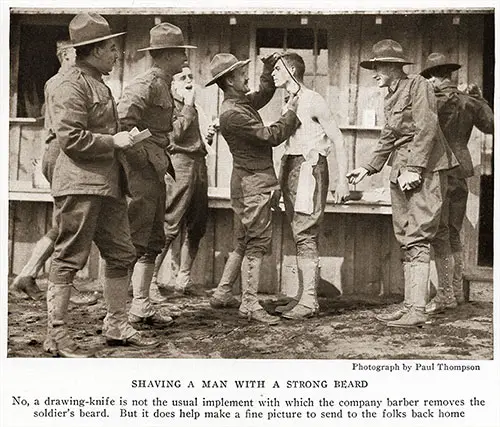
Shaving a Soldier With a Strong Beard. No, a Drawing-Knife Is Not the Usual Implement With Which the Company Barber Removes the Soldier’s Beard. but It Does Help Make a Fine Picture to Send to the Folks Back Home. Photograph by Paul Thompson. National Geographic, November 1917. | GGA Image ID # 231da2e73b
✨ Why This Collection Matters
The WWI training camps show how America transformed from a small peacetime army into a modern military force capable of fighting in Europe. They embody the social and cultural shift of 1917–18, when millions of young men were turned into soldiers — and entire communities rallied to support them.
💡 Students: Use camp brochures, maps, and soldier accounts as primary sources in essays on mobilization, social history, and wartime culture.
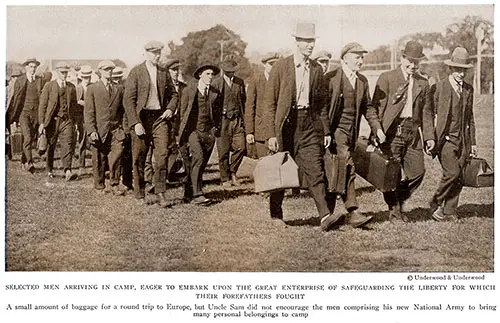
Selected Men Arriving in Camp, Eager to Embark Upon the Great Enterprise, or Safeguarding the Liberty for Which Their Forefathers Fought. A Small Amount of Baggage for a Round Trip to Europe, but Uncle Sam Did Not Encourage the Men Comprising His New National Army to Bring Many Personal Belongings to Camp. Photograph by Underwood & Underwood. | GGA Image ID # 18cc369f7f
📘 Availability & Public Domain Status
Publisher: Government Printing Office & private printers (various)
Dates: 1917–1919
Status: Public Domain
Where Found: Surviving copies appear in military collections, archives, and online repositories (HathiTrust, Internet Archive).
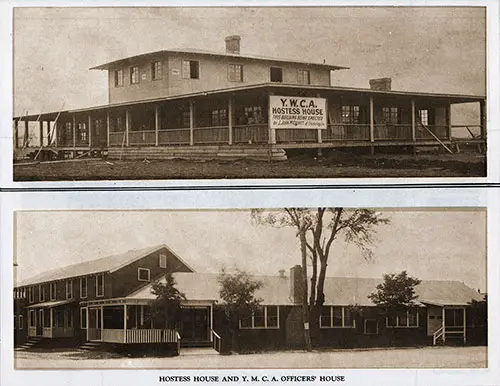
Hostess House and Y.M.C.A. Officers' House at Camp Zachary Taylor, 1918. Camp Zachary Taylor Pctorial, 1928. | GGA Image ID #
🔗 Related Materials
Manuals & Regulations → “the very manuals used in camp training.”
Unit Histories
346th Infantry Unit History - Trained at Camp Pike, Arkansas, and Deployed from Camp Dix to England and France.
351st Infantry Unit History - The accounts of the 351st Regiment of Infantry of the 88th Division in World War I. HQ in Camp Dodge, Iowa.
88th Divsion History - The main units of that comprise the 88th Division: 337th Machine Gun Battalion, 175th Infantry, 349th Infantry, 350th Infantry, 338th Machine Gun Battalion, and various units of the 313th. Comprised mostly of men from the Upper Midwest, Minnesota, Iowa, South Dakota, North Dakota.
Camp Dix Review (Camp Newspaper)
- Camp Dix Pictorial Review-1917-11
- Camp Dix Pictorial Review-1918-02-20
- Camp Dix Pictorial Review-1918-03-20
- Camp Dix Pictorial Review-1918-04-20
- Camp Dix Pictorial Review-1918-05-20
- Camp Dix Pictorial Review-1918-06-20
- Camp Dix Pictorial Review-1918-07-20
- Camp Dix Pictorial Review-1918-10-20
- Character Building By Uncle Sam-1918 - A glimpse into the making of a World War 1 era soldier - this story takes place near Wrightstown, New Jersey at the new Army training facility called Camp Dix. This tabloid size paper was produced during 1918.
Articles and Homefront Materials
- Socializing And Entertainment at Camp Devens - The need for socializing and entertainment for the troops at Camp Devens was undertaken by three primary organizations. The YMCA, The Knights of Columbus, and The Hostess House. The latter being primarily for the benefit of women who visited Camp Devens.
- Hostess House at Camp Dix
- Knights Of Columbus at Camp Dix
- Post Exchange at Camp Dix
- War Work Of The Houstess House Commitee-1919
- War Work Of The YWCA-1918
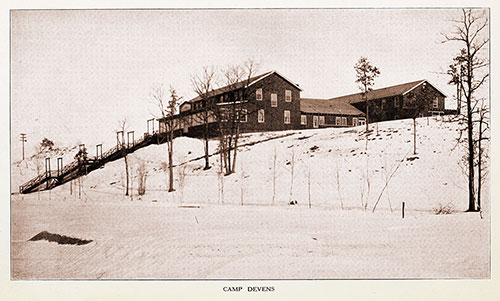
Camp Devens Hostess House. Report of the Hostess House Committee, 1919. | GGA Image ID # 180047379a

